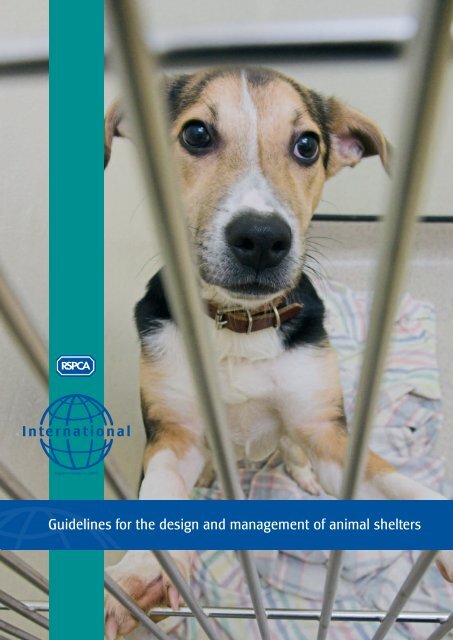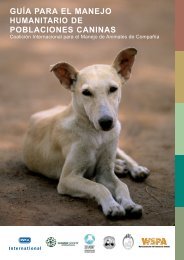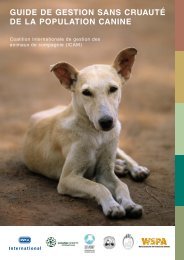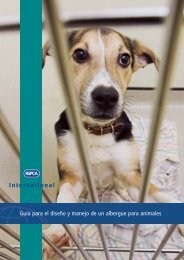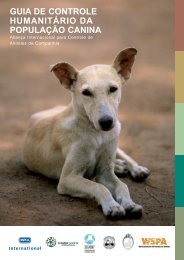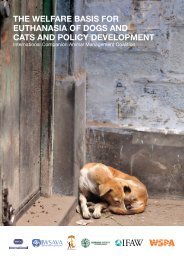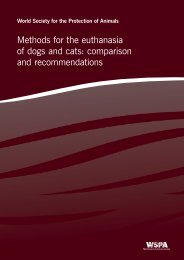Guidelines for the design and management of animal shelters
Guidelines for the design and management of animal shelters
Guidelines for the design and management of animal shelters
Create successful ePaper yourself
Turn your PDF publications into a flip-book with our unique Google optimized e-Paper software.
InternationalRegistered charity no. 219099<strong>Guidelines</strong> <strong>for</strong> <strong>the</strong> <strong>design</strong> <strong>and</strong> <strong>management</strong> <strong>of</strong> <strong>animal</strong> <strong>shelters</strong>
CONTENTSINTRODUCTION 3SECTION 1:IS OPENING AN ANIMAL SHELTERTHE RIGHT OPTION? 4ANDREW FORSYTH/RSPCA PHOTOLIBRARYSECTION 2: ESTABLISHING SHELTER POLICIES 6Neutering 6Rehoming 7Euthanasia 7ABOVE: Hungarianwire-haired vizslaBELOW: Kitten in anRSPCA <strong>animal</strong> centreSECTION 3: DESIGNING THE SHELTER 9Finance 9Site selection 10The building – layout 11SECTION 4: ESTABLISHING SHELTER ROUTINES 13Incoming <strong>animal</strong>s 13Rehoming 13Daily routines 14Feeding 14Hygiene <strong>and</strong> cleaning 14Record keeping 15ANDREW FORSYTH/RSPCA PHOTOLIBRARYSECTION 5: STAFF ISSUES 16Staff <strong>and</strong> volunteers 16Health <strong>and</strong> safety 16CHECKLIST FOR PLANNING AN ANIMAL SHELTER 17CONTENTS<strong>Guidelines</strong> <strong>for</strong> <strong>the</strong> <strong>design</strong> <strong>and</strong> <strong>management</strong> <strong>of</strong> <strong>animal</strong> <strong>shelters</strong> 3
INTRODUCTIONThe RSPCA (Royal Society <strong>for</strong> <strong>the</strong> Prevention <strong>of</strong> Cruelty to Animals) is <strong>the</strong> world’s oldest <strong>animal</strong> welfare organisation.Founded in 1824, <strong>the</strong> Society aims to prevent cruelty <strong>and</strong> promote kindness to <strong>animal</strong>s. The RSPCA is a charity that hasgrown into an organisation with more than 110 <strong>animal</strong> <strong>shelters</strong> <strong>and</strong> clinics, as well as specialised veterinary <strong>and</strong> wildlifehospitals. The RSPCA’s 323 inspectors investigate reports <strong>of</strong> cruelty, <strong>of</strong>fer advice <strong>and</strong> in<strong>for</strong>mation in most cases, orprosecute under UK law when appropriate. The RSPCA also provides advice <strong>and</strong> support to nearly 400 organisations in80 countries around <strong>the</strong> world.The purpose <strong>of</strong> this booklet is to set out all <strong>the</strong> areas to considerwhen building an <strong>animal</strong> shelter. The booklet stresses <strong>the</strong> fact thatbuilding a shelter may not be <strong>the</strong> best solution in every situation<strong>and</strong> suggests some alternative projects to consider – see Section 1:Is building an <strong>animal</strong> shelter <strong>the</strong> right option?ANIMALS’ NEEDSAll <strong>animal</strong>s must carry out basic life processes <strong>and</strong> <strong>the</strong>re<strong>for</strong>e havebasic needs. Humans <strong>and</strong> non-human <strong>animal</strong>s share <strong>the</strong>se basicneeds, which can be grouped into five areas:1. Physiological needs – e.g. food <strong>and</strong> water, appropriatetemperature/humidity, air <strong>and</strong> light conditions etc.2. Social needs – preference <strong>for</strong> living in solitude, in pairbonds or in a group.3. Psychological needs – appropriate stimulation <strong>and</strong>activity to prevent boredom.4. Environmental needs – suitable home, space <strong>and</strong> territory.5. Behavioural needs – e.g. hibernation, nest building, burrowing.Animals in captivity, such as pets or <strong>animal</strong>s in a shelter or zoo, areentirely dependent upon humans to provide <strong>the</strong> conditions thatwill satisfy <strong>the</strong>ir basic needs. It is <strong>the</strong>re<strong>for</strong>e important that anyonelooking after <strong>animal</strong>s is aware <strong>of</strong> all <strong>the</strong>ir needs.THE FIVE FREEDOMSThe RSPCA believes that <strong>the</strong> welfare <strong>of</strong> <strong>animal</strong>s must take intoaccount five essential ‘freedoms’. These five freedoms <strong>for</strong>m <strong>the</strong>basis <strong>of</strong> <strong>the</strong> RSPCA’s policy on <strong>animal</strong> welfare. They were firstdeveloped by <strong>the</strong> UK government’s independent advisory body onfarm <strong>animal</strong>s, <strong>the</strong> Farm Animal Welfare Council, but <strong>the</strong>y provide auseful benchmark <strong>for</strong> <strong>the</strong> welfare <strong>of</strong> <strong>animal</strong>s in <strong>shelters</strong> too.FREEDOM FROM HUNGER AND THIRSTBy providing ready access to fresh water <strong>and</strong> a balanced diet thatmaintains health <strong>and</strong> vigour.FREEDOM FROM PAIN, INJURY AND DISEASEBy prevention or rapid diagnosis <strong>and</strong> treatment.FREEDOM FROM FEAR AND DISTRESSBy ensuring conditions <strong>and</strong> treatment which avoidmental suffering.FREEDOM FROM DISCOMFORTBy providing an appropriate environment including shelter <strong>and</strong> acom<strong>for</strong>table resting <strong>and</strong> sleeping area.FREEDOM TO EXPRESS NORMAL BEHAVIOURBy providing sufficient space, proper facilities <strong>and</strong> appropriatecompany <strong>of</strong> <strong>the</strong> <strong>animal</strong>s’ own kind.Kennel block at Java <strong>animal</strong> shelter, PortugalRSPCA INTERNATIONAL3INTRODUCTION<strong>Guidelines</strong> <strong>for</strong> <strong>the</strong> <strong>design</strong> <strong>and</strong> <strong>management</strong> <strong>of</strong> <strong>animal</strong> <strong>shelters</strong>
SECTION 2: ESTABLISHING SHELTER POLICIESThere are a number <strong>of</strong> policy decisions that need to be taken by your organisation be<strong>for</strong>e you begin to build a shelter,because <strong>the</strong>y will shape many o<strong>the</strong>r factors such as how many <strong>animal</strong>s you can house <strong>and</strong> what facilities you will needto include in <strong>the</strong> building plans.The most important policy decisions are on neutering, rehoming<strong>and</strong> euthanasia. These are all emotive subjects, but taking timeto set clear policies on <strong>the</strong>se issues at an early stage will ensurethat money is not wasted in building a shelter that does not meetyour needs.The establishment <strong>of</strong> policies helps to guide an organisation’s work<strong>and</strong> will shape <strong>the</strong> day-to-day running <strong>of</strong> your shelter. The policiesat your shelter should represent <strong>the</strong> considered position held byyour organisation on particular issues <strong>and</strong> will reflect <strong>the</strong> principlesyour organisation sees as important.Benefits <strong>of</strong> establishing shelter policies:■■■■sets, maintains <strong>and</strong> monitors st<strong>and</strong>ardsensures continuity <strong>of</strong> <strong>animal</strong> careprevents misunderst<strong>and</strong>ing <strong>and</strong> confusion <strong>for</strong>staff <strong>and</strong> supportersensures compliance with relevant legislation.There are several alternate options to consider when developingpolicies on neutering, rehoming <strong>and</strong> euthanasia.NEUTERINGNeutering <strong>animal</strong>s, although very desirable <strong>for</strong> population-controlpurposes, is expensive. Your organisation will need to weigh up <strong>the</strong>costs <strong>of</strong> neutering against <strong>the</strong> benefits be<strong>for</strong>e deciding on yourshelter’s policy. The RSPCA recommends neutering all <strong>animal</strong>sbe<strong>for</strong>e rehoming <strong>the</strong>m.The RSPCA advocates <strong>the</strong> neutering <strong>of</strong> domestic cats <strong>and</strong>dogs <strong>and</strong> o<strong>the</strong>r domestic <strong>animal</strong>s as an important part <strong>of</strong>responsible ownership.Option 1: Not neutering shelter <strong>animal</strong>sThis option would contribute to <strong>the</strong> population control problem<strong>and</strong> could result in a second generation <strong>of</strong> <strong>animal</strong>s arriving at yourshelter that, in turn, could aggravate <strong>the</strong> over-crowding problem.Not neutering <strong>animal</strong>s could also lead to heightened aggressionbetween <strong>animal</strong>s in <strong>the</strong> shelter. On <strong>the</strong> positive side, this option ischeaper <strong>for</strong> <strong>the</strong> shelter.Option 2: Neutering all <strong>animal</strong>s be<strong>for</strong>e rehomingWith this option, it is important to consider <strong>the</strong> cost – who will pay?The <strong>animal</strong>s could be difficult to rehome if neutering is seen as‘unnatural’ or if <strong>the</strong> costs are passed on to <strong>the</strong> adopters. However,<strong>the</strong> <strong>animal</strong>s will be healthier <strong>and</strong> it will also contribute to controlling<strong>the</strong> population. Also your local vet may be willing to per<strong>for</strong>m <strong>the</strong>neutering at cost price or give a discount <strong>for</strong> bulk work.Option 3: Neutering only male <strong>animal</strong>sIt is less expensive to neuter males than females, since <strong>the</strong> surgeryrequired <strong>for</strong> males is much simpler. Neutering <strong>the</strong> males will helpto prevent disease, fighting <strong>and</strong> roaming.Option 5: Neutering only female <strong>animal</strong>sThis option is more expensive than neutering males, however, <strong>the</strong>benefits are that it reduces <strong>the</strong> risk <strong>of</strong> pyometra (infection <strong>of</strong> <strong>the</strong>uterus) <strong>and</strong> may improve chances to rehome as <strong>the</strong> female will notcome into season.Neutering policy being put into practice in Sri LankaRSPCA INTERNATIONALSECTION 2<strong>Guidelines</strong> <strong>for</strong> <strong>the</strong> <strong>design</strong> <strong>and</strong> <strong>management</strong> <strong>of</strong> <strong>animal</strong> <strong>shelters</strong> 6
REHOMINGYour rehoming policy will directly affect <strong>the</strong> length <strong>of</strong> time <strong>animal</strong>sspend in your shelter. Consequently <strong>the</strong> policy has a great influenceon <strong>the</strong> overall capacity <strong>of</strong> your shelter. By specifying certain criteria<strong>for</strong> potential adopters, you will reduce <strong>the</strong> number <strong>of</strong> acceptablehomes. However, careful rehoming can reduce <strong>the</strong> likelihood <strong>of</strong><strong>animal</strong>s being poorly cared <strong>for</strong>, returned to <strong>the</strong> shelter or ab<strong>and</strong>oned.In planning your rehoming policy you should consider <strong>the</strong>following options.Option 1: Rehome <strong>animal</strong>s only to homes meeting certaincriteria (e.g. having fenced yards).This option could potentially lose your shelter good homes <strong>for</strong><strong>animal</strong>s <strong>and</strong> could also be seen as socially or culturally discriminatory.Option 2: Rehome <strong>animal</strong>s only after a home visit has beencarried out.A home visit is used to establish whe<strong>the</strong>r <strong>the</strong> adopter’s environmentis suitable. However, it is labour intensive <strong>and</strong> delays <strong>the</strong> rehomingprocess. Also some cultures would find <strong>the</strong> concept <strong>of</strong> home visitsunacceptable, so you would need to consider if <strong>the</strong>y are appropriatein your country.Option 3: Rehome to people that can af<strong>for</strong>d to pay anadoption fee.Adoption fees generate funds <strong>for</strong> <strong>the</strong> shelter <strong>and</strong> also indicate alevel <strong>of</strong> commitment from <strong>the</strong> adopter. Also, if potential adopters areunable to pay an adoption fee, <strong>the</strong>y are unlikely to be able to covercosts such as veterinary treatment in <strong>the</strong> future. However, paying anadoption fee would be no guarantee <strong>of</strong> providing a good home.Animals could be returned <strong>and</strong> <strong>the</strong> shelter may even be seen as acommercial enterprise. Fees can put some people <strong>of</strong>f adopting insome countries, or be financially difficult.Option 4: Rehoming only after interviewingpotential adopters.This will enable you to identify unsuitable adopters, <strong>and</strong> will alsoenable <strong>the</strong> shelter to match <strong>the</strong> adopter to a suitable <strong>animal</strong>.The interview will also provide <strong>the</strong> opportunity to confirm <strong>the</strong>adopter’s underst<strong>and</strong>ing <strong>of</strong> pet ownership. However, this processcan be time consuming.Setting strict conditions on who may adopt an <strong>animal</strong> willrestrict <strong>the</strong> number <strong>of</strong> potential homes, but it will ultimatelyensure good care is <strong>of</strong>fered in <strong>the</strong>se homes.See Section 4: Establising shelter routines <strong>for</strong> <strong>the</strong> RSPCA’srehoming procedures.EUTHANASIADeciding under what circumstances an <strong>animal</strong> will be euthanasedis undoubtedly one <strong>of</strong> <strong>the</strong> most difficult policy decisions that yourorganisation will have to make. In planning your euthanasia policy,as well as taking account <strong>of</strong> <strong>the</strong> law in your country, you should alsoconsider <strong>the</strong> pros <strong>and</strong> cons <strong>of</strong> <strong>the</strong> following options.Option 1: A no-kill policy.This option could prolong <strong>the</strong> suffering <strong>of</strong> sick or injured <strong>animal</strong>s<strong>and</strong> could also result in <strong>the</strong> spread <strong>of</strong> disease. The shelter couldturn into a long-term sanctuary, <strong>and</strong> although this may producegood public relations because many <strong>of</strong> <strong>the</strong> general public stillperceive euthanasia as cruel, you run <strong>the</strong> risk <strong>of</strong> over-crowding orneeding to turn <strong>animal</strong>s away. If your organisation is committedto <strong>animal</strong> welfare having a no kill policy is not a viable option. Incountries where <strong>the</strong>re is a large stray or street population, <strong>the</strong>shelter will quickly become over crowded unless <strong>the</strong> capacity isadhered to <strong>and</strong> <strong>animal</strong>s will die from fighting or disease, which isfar more cruel than euthanasia by a vet.Option 2: Euthanasia <strong>of</strong> terminally ill <strong>animal</strong>s only.This option would reduce <strong>the</strong> suffering <strong>of</strong> sick <strong>animal</strong>s <strong>and</strong>also reduce <strong>the</strong> spread <strong>of</strong> disease. It would result in a healthierpopulation at <strong>the</strong> shelter <strong>and</strong> would also reduce <strong>the</strong> vet fees.Option 3: Euthanasia <strong>of</strong> <strong>animal</strong>s that cannot be rehomed(e.g. aggressive <strong>animal</strong>s).This could produce poor public relations <strong>for</strong> your shelter, however itwould prevent long-term kennel stress <strong>and</strong> would also allow space<strong>and</strong> adoption <strong>of</strong> <strong>animal</strong>s that can be rehomed. It would also prevent<strong>the</strong> shelter from getting a reputation <strong>for</strong> rehoming dangerous orproblem <strong>animal</strong>s.Option 4: Euthanasia after <strong>animal</strong>shave been at <strong>the</strong> shelter <strong>for</strong> a set time.This would reduce <strong>the</strong> potential <strong>for</strong> over-crowding at your shelter<strong>and</strong> <strong>the</strong> population would be healthier, as <strong>the</strong> risk <strong>of</strong> spread <strong>of</strong>disease would be lower. However, it could generate bad publicrelations <strong>and</strong> also means <strong>the</strong> cost <strong>of</strong> worming <strong>and</strong> vaccinating <strong>the</strong>euthanased <strong>animal</strong>s has been unnecessary.If your organisation wishes to ensure maximum levels <strong>of</strong>adoption from your shelter, <strong>and</strong> <strong>the</strong>re is a large problemwith stray <strong>and</strong> unwanted <strong>animal</strong>s, you may at times have toaccept <strong>the</strong> need <strong>for</strong> <strong>the</strong> euthanasia <strong>of</strong> healthy <strong>animal</strong>s. Thisdecision should be made by assessing <strong>the</strong> likelihood <strong>of</strong> an<strong>animal</strong> being rehomed.7SECTION 2<strong>Guidelines</strong> <strong>for</strong> <strong>the</strong> <strong>design</strong> <strong>and</strong> <strong>management</strong> <strong>of</strong> <strong>animal</strong> <strong>shelters</strong>
Any time limit that is set should take into account:■■■■■<strong>the</strong> shelter’s capacity<strong>the</strong> amount <strong>of</strong> time staff or volunteers can spendwith each <strong>animal</strong> to ensure it remains sociable <strong>and</strong><strong>the</strong>re<strong>for</strong>e suitable <strong>for</strong> rehoming<strong>the</strong> pressure on kennel space due to incoming strayor unwanted dogswhe<strong>the</strong>r <strong>animal</strong>s are kept in individual kennels orgroup housingyour country’s legislation that may prohibit euthanasiaor set a maximum time limit.The RSPCA is opposed to <strong>the</strong> euthanasia <strong>of</strong> fit <strong>and</strong> healthy <strong>animal</strong>s.The Society never<strong>the</strong>less accepts with great reluctance, that incertain circumstances euthanasia may be necessary, in particularin <strong>the</strong> case <strong>of</strong> unwanted or stray <strong>animal</strong>s <strong>for</strong> which good homesare not available.Once policies have been agreed, care should be taken to monitor<strong>the</strong>ir effectiveness. At all times <strong>the</strong> welfare <strong>of</strong> <strong>the</strong> <strong>animal</strong>s must beparamount. Even with <strong>the</strong> best intentions, an over-crowded orbadly run shelter can cause great suffering to <strong>the</strong> very <strong>animal</strong>sit is intended to help.Areas to consider when establishing your shelter policies:■ aims■ benefits■ financial costs■ public opinion■ effectiveness■ staff.It is important to consider <strong>the</strong> consequences <strong>the</strong>se policies willhave on your organisation as a whole <strong>and</strong> on issues such as finance<strong>and</strong> public opinion.Your organisation will need to weigh up <strong>the</strong> actual cost <strong>of</strong>implementing <strong>the</strong> policy, against <strong>the</strong> perceived benefit.Family looking at a dog waiting to be rehomed at an <strong>animal</strong> centreANDREW FORSYTH/RSPCA PHOTOLIBRARYSECTION 2<strong>Guidelines</strong> <strong>for</strong> <strong>the</strong> <strong>design</strong> <strong>and</strong> <strong>management</strong> <strong>of</strong> <strong>animal</strong> <strong>shelters</strong> 8
SECTION 3: DESIGNING THE SHELTERRunning a shelter is a huge financial commitment, <strong>and</strong> a major responsibility. The greatest <strong>of</strong> care must <strong>the</strong>re<strong>for</strong>e be takenin <strong>the</strong> planning stages to ensure that money is not wasted <strong>and</strong> that <strong>the</strong> shelter you build is <strong>the</strong> best possible within yourfinancial constraints.Your priorities should be:■ <strong>the</strong> needs <strong>of</strong> <strong>the</strong> <strong>animal</strong>s <strong>and</strong> <strong>the</strong> safety <strong>of</strong> <strong>the</strong> staff <strong>and</strong> public■ <strong>the</strong> needs <strong>of</strong> <strong>the</strong> people looking after <strong>the</strong> <strong>animal</strong>s■ <strong>the</strong> needs <strong>of</strong> <strong>the</strong> people visiting <strong>the</strong> shelter.See <strong>the</strong> Checklist <strong>for</strong> planning an <strong>animal</strong> shelter at <strong>the</strong> end <strong>of</strong> this booklet.FINANCEShelters are expensive, both to build <strong>and</strong> run. Be<strong>for</strong>e you begin tobuild, provision should first be made <strong>for</strong> <strong>the</strong> following.CAPITAL EXPENDITUREThese are items <strong>of</strong> non-recurring expenditure, such as:■ purchase <strong>of</strong> l<strong>and</strong>■ consultants’ fees (architects, surveyors etc.)■ building materials■ connection <strong>of</strong> services (electricity, water, drainage)■ equipment■ building a road.Allowances will have to be made <strong>for</strong> replacement <strong>of</strong> equipment byallowing a sum <strong>for</strong> ‘depreciation’ in your accounts.If you have a sum set aside <strong>for</strong> building your shelter, you shoulddecide what proportion <strong>of</strong> it should be spent initially <strong>and</strong> how muchshould be invested to provide a regular income. It is better to run<strong>and</strong> build a small, good shelter than to build a large shelter that youcannot af<strong>for</strong>d to run properly.RUNNING COSTSThese comprise all items <strong>of</strong> day-to-day expenditure associated withyour shelter. They will include:■ food■ depreciation■ insurance■ veterinary drugs/charges■ light/heat/water■ cleaning materials■ salaries <strong>and</strong> staff costs.It is important to make a realistic assessment <strong>of</strong> <strong>the</strong>se costs be<strong>for</strong>eyou begin to construct your shelter.INCOMEWhen preparing your financial plan <strong>for</strong> <strong>the</strong> shelter you must make arealistic estimate <strong>of</strong> your likely annual income. This will include allknown sources <strong>of</strong> income, toge<strong>the</strong>r with an estimation <strong>of</strong> how muchyou hope to fundraise. The welfare <strong>of</strong> <strong>the</strong> <strong>animal</strong>s is <strong>of</strong> paramountimportance, <strong>and</strong> <strong>the</strong>y cannot be cared <strong>for</strong> without money.CASE STUDY 3In many countries local authorities have an obligation t<strong>of</strong>inance a system to control stray <strong>animal</strong>s within <strong>the</strong>irmunicipality or region. Local authority contracts can provideregular income <strong>for</strong> an organisation running an <strong>animal</strong>shelter. This money can be used to cover <strong>the</strong> cost <strong>of</strong> food,cleaning, heating <strong>and</strong> equipment, as well as largegrants to pay <strong>for</strong> building <strong>and</strong> maintenance work.However, money from a government contract comeswith an obligation to provide a service <strong>and</strong> it isimportant to negotiate a contract that clearly outlines<strong>the</strong> responsibilities <strong>of</strong> both parties.For a number <strong>of</strong> years an <strong>animal</strong> welfare group inEurope successfully ran small-scale projects in a citywhere provision <strong>for</strong> stray <strong>animal</strong>s was severely lacking.The group’s initial shelter project had been running well<strong>and</strong> it decided to exp<strong>and</strong> its operations. An opportunitycame when <strong>the</strong> local authority in a neighbouring cityinvited companies to bid <strong>for</strong> <strong>the</strong> right to provide its stray<strong>animal</strong> services. The <strong>animal</strong> welfare organisation decidedto put <strong>for</strong>ward its own proposal.In an ef<strong>for</strong>t to win at all costs, <strong>the</strong> group repeatedly undercut<strong>the</strong> prices being <strong>of</strong>fered by pr<strong>of</strong>essional companies. While ithad <strong>the</strong> best <strong>of</strong> intentions, <strong>the</strong> group undercut a number <strong>of</strong>companies with a proven track record <strong>of</strong> providing effective<strong>and</strong> humane services.The local authority was able to remove an obligation t<strong>of</strong>inance building work <strong>and</strong> purchase new equipment from<strong>the</strong> contract. The bid from <strong>the</strong> <strong>animal</strong> welfare organisationresulted in staff wages being lowered to unacceptablelevels <strong>and</strong> also allowed <strong>the</strong> local authority to remove itsobligation to cover <strong>the</strong> cost <strong>of</strong> vaccinations <strong>for</strong> <strong>the</strong> staff<strong>and</strong> <strong>animal</strong>s. The organisation won <strong>the</strong> contract to runa shelter, but only in run-down facilities with poorly paid<strong>and</strong> unmotivated staff. The group eventually had to usefunds <strong>and</strong> personnel from its original shelter to improve<strong>the</strong> second project <strong>and</strong> <strong>the</strong> st<strong>and</strong>ard <strong>of</strong> care at <strong>the</strong> originalshelter dropped dramatically.9SECTION 3<strong>Guidelines</strong> <strong>for</strong> <strong>the</strong> <strong>design</strong> <strong>and</strong> <strong>management</strong> <strong>of</strong> <strong>animal</strong> <strong>shelters</strong>
After six months, <strong>the</strong> group withdrew from <strong>the</strong>contract at considerable financial <strong>and</strong> emotionalcost to its organisation.Be<strong>for</strong>e making a bid <strong>for</strong> a contract with a local authority,it is essential that you make an in-depth analysis <strong>of</strong> yourbid to ensure it is good <strong>for</strong> your organisation, staff <strong>and</strong> <strong>the</strong><strong>animal</strong>s you care <strong>for</strong>, in <strong>the</strong> long-term. There will <strong>of</strong>ten becircumstances under which it is more appropriate to allow<strong>the</strong> contract to pass to ano<strong>the</strong>r organisation. Your groupcan <strong>the</strong>n monitor <strong>and</strong> support its operations.SITE SELECTION■■■■■■■■■■Should you lease or buy a site? Does <strong>the</strong> site haveroom <strong>for</strong> expansion?Is <strong>the</strong> site a minimum <strong>of</strong> 400 metres from <strong>the</strong> nearestresidential housing? You will need to check localplanning requirements.Is <strong>the</strong> site on high ground with good natural drainage?Can <strong>the</strong> site be easily reached by public transport?This may be important <strong>for</strong> your staff <strong>and</strong> <strong>for</strong>potential adopters.Can mains water/drainage/electricity be connected<strong>and</strong> at what cost?What building materials are readily available?What materials are recommended <strong>for</strong> localclimatic conditions?Should you convert an existing building or build new?Conversions may be cheaper, but may not be assuitable as a purpose-built shelter.What are <strong>the</strong> opinions <strong>of</strong> <strong>the</strong> local people?CASE STUDY 4RSPCA International has encountered many examples <strong>of</strong><strong>animal</strong> <strong>shelters</strong> in inappropriate locations. Old municipal<strong>shelters</strong> are <strong>of</strong>ten built to poor st<strong>and</strong>ards <strong>and</strong> are located faraway from <strong>the</strong> city centre <strong>and</strong> major transport links. All <strong>of</strong><strong>the</strong>se factors can contribute to low rehoming rates, higherlevels <strong>of</strong> euthanasia <strong>and</strong> demoralising conditions <strong>for</strong> bothvisitors <strong>and</strong> staff. In an ef<strong>for</strong>t to rectify this situation someorganisations have chosen to buy or lease l<strong>and</strong> closer to <strong>the</strong>city centre. The pitfall here is that it is difficult to guaranteeadequate space <strong>for</strong> any potential expansion.This was underlined when an <strong>animal</strong> rescue organisation inEurope needed to undertake important renovation <strong>of</strong> itsshelter. Despite strong support from <strong>the</strong> local authority, whichhad part-funded <strong>the</strong> shelter’s running costs since its inception,<strong>the</strong> location <strong>of</strong> <strong>the</strong> shelter brought it into conflict with o<strong>the</strong>rorganisations <strong>and</strong> developers. These two groups opposed <strong>the</strong>project vigorously. Resident groups usually dislike <strong>the</strong> loudnoise levels created by an <strong>animal</strong> shelter near <strong>the</strong>ir property.The subsequent dispute over planning permission has beenongoing <strong>for</strong> three years without a satisfactory resolution. Thefinancial implications <strong>of</strong> this dispute with <strong>the</strong> local authoritymay even jeopardise <strong>the</strong> shelter’s very existence.It is difficult to plan <strong>for</strong> unexpected events in <strong>the</strong> future, butit is essential to have a strategy that takes future needs <strong>of</strong>your <strong>animal</strong> shelter <strong>and</strong> organisation into account. It isimportant to ensure that your involvement in shelter workwill not have a negative impact on <strong>the</strong> growth <strong>of</strong> your entireorganisation. There<strong>for</strong>e it is necessary to have secured <strong>the</strong>appropriate funding, space <strong>and</strong> resources to allow <strong>for</strong> <strong>the</strong>potential expansion <strong>of</strong> a shelter <strong>and</strong> it is vital to be anadequate distance from residential housing. Planningregulations vary from town to town, but an organisationshould have a clear underst<strong>and</strong>ing <strong>of</strong> regulations be<strong>for</strong>eselecting <strong>the</strong> site <strong>for</strong> a new shelter.THE BUILDING – LAYOUTSECTION 3<strong>Guidelines</strong> <strong>for</strong> <strong>the</strong> <strong>design</strong> <strong>and</strong> <strong>management</strong> <strong>of</strong> <strong>animal</strong> <strong>shelters</strong> 10
THE BUILDING –LAYOUTWhen deciding <strong>the</strong> layout <strong>of</strong> your shelter, preventing <strong>the</strong> spread<strong>of</strong> disease must be your first priority. Incoming <strong>animal</strong>s must bequarantined away from <strong>animal</strong>s that are ready <strong>for</strong> rehoming.Isolation <strong>and</strong> quarantine areas must not be accessible to <strong>the</strong>general public.STAFF AND PUBLIC SPACES1. RECEPTION AREA: You must consider every procedure<strong>and</strong> activity regularly undertaken here, including <strong>the</strong>traffic flow <strong>of</strong> people using this area. The receptionarea should give a good first impression <strong>and</strong> will<strong>the</strong>re<strong>for</strong>e need to communicate a sense <strong>of</strong> order,<strong>and</strong> be light <strong>and</strong> clean.2. ADMINISTRATIVE OFFICE: This is <strong>the</strong> control centre <strong>for</strong><strong>the</strong> shelter, <strong>and</strong> it should have direct access both to<strong>the</strong> reception area <strong>and</strong> <strong>the</strong> <strong>animal</strong> quarters. You willneed to keep accurate records <strong>of</strong> all <strong>animal</strong>s entering<strong>and</strong> leaving your shelter, so you must allow sufficientspace <strong>for</strong> <strong>the</strong> storage <strong>of</strong> records, including future growth.3. MEDICAL/EUTHANASIA ROOM: This should be adjacentto <strong>the</strong> isolation/quarantine facility to allow <strong>the</strong> easymovement <strong>of</strong> sick <strong>and</strong> recovering <strong>animal</strong>s. Thereshould be a separate entrance from outside <strong>and</strong> clearaccess <strong>for</strong> vehicles. There should be a separateventilation system <strong>for</strong> this area, <strong>and</strong> <strong>the</strong>re should beisolation units that prevent any physical contactbetween <strong>animal</strong>s.4. CARCASS ROOM/COLD STORAGE: This should beadjacent to <strong>the</strong> euthanasia room – a cold room,refrigerator or freezer may be required. Be<strong>for</strong>e decidingon <strong>the</strong> method that you will use to dispose <strong>of</strong> carcasses,you must check with <strong>the</strong> local authorities <strong>for</strong> anyhealth <strong>and</strong> pollution regulations that may affect yourchoice. If you are going to have a crematorium on site,<strong>the</strong>n a dedicated space must be set aside <strong>for</strong> thispurpose. If disposal is to take place <strong>of</strong>f <strong>the</strong> premises,<strong>the</strong>n a larger cold storage room will be needed.5. ANIMAL FOOD PREPARATION: This area will require asink with hot <strong>and</strong> cold running water <strong>and</strong> a refrigerator.You should ensure that <strong>the</strong>re is an area to disinfectfeeding bowls, <strong>and</strong> that you have sufficient counterspace on which to place <strong>the</strong> bowls. The food storageshould be adjacent, <strong>and</strong> all food should be stored <strong>of</strong>f<strong>the</strong> floor in vermin-pro<strong>of</strong> containers.6. HYGIENE AREA: Staff will require a wash area <strong>and</strong>toilets, toge<strong>the</strong>r with a shower area if possible.RSPCA INTERNATIONALANIMAL SPACE1. FLOORS: To guard against infection, all floors shouldhave a smooth impervious surface e.g. tiles. Concretecan be used if it is hardened <strong>and</strong> treated to beimpervious. In outside areas, gravel flooring ispreferable to grass or earth, but must be thoroughlywashed frequently. Wood is not advised as itdeteriorates <strong>and</strong> paving is also difficult to keep clean.2. WALLS: These should be sealed e.g. with chlorinatedrubber paint, so that <strong>the</strong>y can be properly cleaned.There should be no gaps or cracks that canharbour disease.3. DRAINAGE: Floors should slope towards a drain that isoutside <strong>the</strong> <strong>animal</strong> living areas. A drain opening <strong>of</strong>not less than 20cm diameter is recommended <strong>and</strong> itshould be covered by a strainer grid. The provision <strong>of</strong>mains sewers, a cesspit or septic tank is essential.DOGSThe following are minimum st<strong>and</strong>ards based on RSPCA experience.1. INDIVIDUAL OR QUARANTINE KENNELS: Each dogshould have a minimum <strong>of</strong> 2m 2 covered <strong>and</strong> draft-freeaccommodation. It should have a raised bed surface.The minimum temperature is 10ºC <strong>and</strong> <strong>the</strong> maximum is26ºC. Sleeping quarters must be ventilated <strong>and</strong> haveboth natural <strong>and</strong> supplementary light.Each dog requires a minimum <strong>of</strong> 2.5–3.5m 2 <strong>of</strong> open exercise run.Fencing should be at least 2m high <strong>and</strong> be made <strong>of</strong> weld mesh. Itshould slope inwards at <strong>the</strong> top to stop dogs climbing. Animalsmust always have a view outside <strong>the</strong> kennel.2. GROUP HOUSING: This is not suitable <strong>for</strong> ill, injured ornursing <strong>animal</strong>s, or in <strong>shelters</strong> with a high turnover.Minimum space requirements <strong>for</strong> dogs in grouphousing are <strong>the</strong> same as in individual kennels per dog.Dogs should only be put into group housing afterspending 10 days in quarantine. Care must be taken tomatch compatible <strong>animal</strong>s. In group housing you musthave a policy <strong>of</strong> sterilisation or strict separation <strong>of</strong><strong>the</strong> sexes.Attractive kennel buildings can improve rehoming rates– example shown is from a shelter in Pol<strong>and</strong>11SECTION 3<strong>Guidelines</strong> <strong>for</strong> <strong>the</strong> <strong>design</strong> <strong>and</strong> <strong>management</strong> <strong>of</strong> <strong>animal</strong> <strong>shelters</strong>
CATSThe following are minimum st<strong>and</strong>ards based on RSPCA experience.1. Quarantine or individual cages: Cubicles plus exercisearea should be a minimum <strong>of</strong> 2.2m 3 with an openmesh front. Each cubicle should have a bed, a dirt/litter tray <strong>and</strong> space <strong>for</strong> food <strong>and</strong> water bowls. Goodventilation is essential <strong>and</strong> where cubicles face eacho<strong>the</strong>r, <strong>the</strong>y should be separated by at least 2m toprevent <strong>the</strong> spread <strong>of</strong> disease.2. Group housing: Good ventilation is even moreimportant in group housing. Cats need access tocovered, draft-free accommodation with a bed space.Bedding is not required, nor is it recommendedbecause <strong>of</strong> <strong>the</strong> spread <strong>of</strong> infection. The minimumtemperature is 10ºC <strong>and</strong> <strong>the</strong> maximum should notexceed 26ºC. The outdoor space must be totallyenclosed in weld mesh, but can have a solid ro<strong>of</strong>.A sufficient number <strong>of</strong> dirt/litter trays to allow oneper cat are required. The absolute maximum size <strong>of</strong> agroup is 50, but much smaller groups are recommended.In group housing you must have a policy <strong>of</strong> sterilisationor strict separation <strong>of</strong> <strong>the</strong> sexes.LARGE ANIMALSYou may occasionally be called upon to take large <strong>animal</strong>s such ashorses. However, unless you have staff who are trained to deal withlarge <strong>animal</strong>s, horses should only be accepted in an emergency,<strong>and</strong> kept <strong>for</strong> as short a time as possible be<strong>for</strong>e being taken to analternative site where more specialised care is available. You will<strong>the</strong>re<strong>for</strong>e need to identify specialists nearby that would be able tohelp you by ‘fostering’ large <strong>animal</strong>s.When making arrangements make sure you:■■■■check <strong>the</strong> st<strong>and</strong>ard <strong>of</strong> care provided will be adequateagree <strong>the</strong> price you will be chargeddiscuss whe<strong>the</strong>r you will be responsible <strong>for</strong> transporting<strong>the</strong> <strong>animal</strong> to <strong>the</strong> specialist, or if <strong>the</strong>y can collectdraw up a legal contract covering all <strong>the</strong> points discussed.MISCELLANEOUS SMALL ANIMALSMost <strong>shelters</strong> find that <strong>the</strong>y receive a variety <strong>of</strong> small <strong>animal</strong>s o<strong>the</strong>rthan cats <strong>and</strong> dogs. A multi-purpose block can be built, but bear inmind that since it is not a specialist unit, <strong>the</strong> length <strong>of</strong> time <strong>animal</strong>sstay should be as short as possible. You should try <strong>and</strong> avoid having toprovide this additional accommodation by identifying people who areprepared to ‘foster’ <strong>the</strong>se <strong>animal</strong>s until new homes can be found <strong>for</strong><strong>the</strong>m. The same conditions <strong>for</strong> fostering should apply as <strong>for</strong> large <strong>animal</strong>s.The small <strong>animal</strong>s block will need to be equipped with appropriatefood <strong>and</strong> equipment, e.g. cages.Horse in an RSPCA <strong>animal</strong> centreANDREW FORSYTH/RSPCA PHOTOLIBRARYSECTION 3<strong>Guidelines</strong> <strong>for</strong> <strong>the</strong> <strong>design</strong> <strong>and</strong> <strong>management</strong> <strong>of</strong> <strong>animal</strong> <strong>shelters</strong> 12
SECTION 4: ESTABLISHING SHELTER ROUTINESThe establishment <strong>of</strong> effective routines is an important part <strong>of</strong> running a shelter. Well-<strong>design</strong>ed routines help anorganisation to run smoothly <strong>and</strong> consistently achieve set st<strong>and</strong>ards. Routines also help to ensure that all staff are aware<strong>of</strong> <strong>the</strong>ir responsibilities. Routines should be established <strong>for</strong> admitting <strong>animal</strong>s, rehoming procedures <strong>and</strong> daily tasks.INCOMING ANIMALSDogs <strong>and</strong> cats must be quarantined on arrival <strong>for</strong> a minimum <strong>of</strong>10 days. This timeframe can be adjusted according to incubationperiods <strong>of</strong> common infectious diseases seen in your shelter or area.It is important that you have a dedicated quarantine area at yourshelter. No contact between <strong>animal</strong>s in quarantine or betweenquarantined <strong>animal</strong>s <strong>and</strong> those ready <strong>for</strong> adoption should beallowed. All <strong>animal</strong>s should be examined by a vet or an experiencedmember <strong>of</strong> staff within 24 hours <strong>of</strong> <strong>the</strong>ir arrival at <strong>the</strong> shelter, orsooner if <strong>the</strong>re is any sign <strong>of</strong> injury or disease. Animals shouldalso be vaccinated <strong>and</strong> wormed on arrival.The time in quarantine gives an opportunity to assess <strong>the</strong> <strong>animal</strong><strong>for</strong> any clinical or behavioural problems. This will help in rehoming<strong>and</strong>/or mixing appropriate <strong>animal</strong>s toge<strong>the</strong>r, particularly incommunal kennels or catteries. In<strong>for</strong>mation ga<strong>the</strong>red at arrival<strong>and</strong> during quarantine should be recorded in paper or electronic<strong>for</strong>m (see Record keeping below).Upon arrival all <strong>animal</strong>s should be:1. quarantined2. examined by a vet3. wormed4. vaccinated.REHOMINGThe purpose <strong>of</strong> an <strong>animal</strong> shelter’s rehoming programme should beto find responsible, life-long homes <strong>for</strong> <strong>animal</strong>s.Your organisation will need to establish a routine <strong>for</strong>rehoming. For instance, will you ask prospective adoptersto fill in a questionnaire? Will you interview <strong>the</strong>m?To ensure an appropriate match between <strong>animal</strong> <strong>and</strong> adopter, it isimportant to know <strong>the</strong> needs <strong>of</strong> both <strong>the</strong> <strong>animal</strong> to be placed <strong>and</strong><strong>the</strong>ir prospective adopter. Spending time refining your rehomingpolicy <strong>and</strong> routines will help to ensure <strong>the</strong> placement is long-term<strong>and</strong> does not increase your workload because <strong>the</strong> <strong>animal</strong>s aresubsequently returned, or cause undue stress to <strong>the</strong> <strong>animal</strong>.It is important to carry out a <strong>for</strong>mal assessment <strong>of</strong><strong>animal</strong>s be<strong>for</strong>e adoption so that:■■<strong>animal</strong>s <strong>and</strong> adopters are suitably matched<strong>animal</strong>s <strong>of</strong> unsound or questionable temperament arenot rehomed.Only healthy <strong>animal</strong>s that are known not to have exhibitedabnormal aggression or o<strong>the</strong>r serious behavioural disordersshould be made available <strong>for</strong> adoption.Dogs should be kept in quarantine <strong>for</strong> seven to 10 days <strong>and</strong> cats<strong>for</strong> 14 days.Example <strong>of</strong> RSPCA’s rehoming processAnimal acceptedAnimal assessedAnimal reclaimedReturned to owner■■Vet checks<strong>and</strong> vaccinationsBehaviourassessmentAnimal unsuitable<strong>for</strong> rehomingEuthanased?Post-adoption home checkAnimal available<strong>for</strong> rehomingProspective adoptervisits shelter <strong>and</strong>selects <strong>animal</strong>Adopter collects <strong>animal</strong>Adopter assessmentQuestionnaire <strong>and</strong>home checkAnimal neuteredPASSFAILPotential adopter is advised that <strong>the</strong>ir situationis not appropriate to adopt at this time13SECTION 4<strong>Guidelines</strong> <strong>for</strong> <strong>the</strong> <strong>design</strong> <strong>and</strong> <strong>management</strong> <strong>of</strong> <strong>animal</strong> <strong>shelters</strong>
Rehoming key points1. The purpose <strong>of</strong> an <strong>animal</strong> shelter’s rehomingprogramme is to find responsible, life-long homes<strong>for</strong> <strong>animal</strong>s.2. It is important to establish a routine <strong>for</strong> rehoming, so thatstaff <strong>and</strong> volunteers know <strong>the</strong> procedures to follow.3. The written outline <strong>of</strong> <strong>the</strong> routine should state what<strong>for</strong>ms are used, <strong>the</strong> sequence <strong>of</strong> <strong>the</strong> process <strong>and</strong> whatfees, if any, are charged.4. Responsible rehoming policies <strong>and</strong> procedures willhelp your organisation make <strong>the</strong> best decisions <strong>for</strong><strong>the</strong> <strong>animal</strong>s being adopted.5. Use a pre-adoption questionnaire to learn as muchas possible about <strong>the</strong> potential adopter’s lifestyle,knowledge <strong>and</strong> commitment.DAILY ROUTINESIt is important that routines are established <strong>and</strong> adhered to <strong>for</strong>feeding, cleaning <strong>and</strong> record keeping. This will ensure that fewermistakes are made <strong>and</strong> that all essential tasks are completedproperly. As part <strong>of</strong> <strong>the</strong> daily work routine, each shelter shoulddetail <strong>the</strong> times by which <strong>the</strong>se duties/tasks must be completed<strong>and</strong> <strong>the</strong> names <strong>of</strong> <strong>the</strong> staff responsible. A basic daily routinewould be as follows.1. Check all cages <strong>and</strong> inspect <strong>animal</strong>s.2. Adjust ventilation <strong>and</strong> heating.3. Clean <strong>and</strong> disinfect kennels, cattery <strong>and</strong>service buildings.4. Clean <strong>and</strong> disinfect feeding utensils.5. Prepare food <strong>and</strong> feed <strong>animal</strong>s.6. Each <strong>animal</strong> should be exercised <strong>and</strong> groomed every day.7. Attend to members <strong>of</strong> <strong>the</strong> public.8. Allow time <strong>for</strong> staff breaks.9. Bed down <strong>animal</strong>s, adjust heating <strong>and</strong> ventilation.10. Secure all buildings.Ideally as many cleaning tasks as possible should becompleted be<strong>for</strong>e <strong>the</strong> shelter is opened to members <strong>of</strong><strong>the</strong> public.You may need to draw up different routines <strong>for</strong> <strong>the</strong> weekends,holidays, etc., but all <strong>of</strong> <strong>the</strong> tasks will still need to be fulfilled, <strong>and</strong>preferably with <strong>the</strong> minimum <strong>of</strong> disruption to <strong>the</strong> normal routines<strong>for</strong> <strong>the</strong> <strong>animal</strong>s.FEEDINGThe feeding regime should be set out clearly. Feeding times shouldbe regular <strong>and</strong> adhered to, <strong>and</strong> concise written instructions shouldbe available <strong>for</strong> staff. Frequent changes are unsettling <strong>for</strong> <strong>animal</strong>s<strong>and</strong> should be avoided.It is a good idea to have a wipeable white board in <strong>the</strong> foodpreparation area, showing <strong>the</strong> dietary requirements <strong>of</strong> each<strong>animal</strong>. The feeding products should not be changed too frequentlysince this can cause digestive upsets in some <strong>animal</strong>s.Food supplies must be regular <strong>and</strong> cost should take second placeto quality, availability <strong>and</strong> sustainability.The principles below should be considered when feeding:■■■■■ensure you provide a balanced dietfresh clean water should be available at all timesdo not organise exercise sessions <strong>for</strong> <strong>the</strong> <strong>animal</strong>simmediately after eatingavoid sudden changes in dietdo not overfeed.The food preparation area must be kept clean <strong>and</strong> orderly. Utensilsshould be practical <strong>and</strong> readily at h<strong>and</strong>. It is advisable to buy goodquality products, as <strong>the</strong>se will prove cheaper in <strong>the</strong> long run. Try tokeep <strong>the</strong> food preparation time to a minimum since <strong>the</strong> time wouldbe better spent socialising with <strong>the</strong> <strong>animal</strong>s.Tinned food provides a complete balanced meal, but <strong>animal</strong>sproduce looser stools, which may result in longer kennelcleaning times.Dry food (ei<strong>the</strong>r moistened or dry) provides a complete high protein,balanced meal. Stools will be very firm – <strong>the</strong> RSPCA uses dry foodwhere possible.O<strong>the</strong>r foods. Avoid using leftovers, if possible. The potential <strong>for</strong>disease with this food is high <strong>and</strong> <strong>the</strong> nutritional value is <strong>of</strong>ten low,as well as being unreliable.HYGIENE AND CLEANINGSystematic cleaning routines are essential to control <strong>the</strong> spread <strong>of</strong>disease. By establishing a set routine <strong>for</strong> cleaning, tasks are lesslikely to be <strong>for</strong>gotten <strong>and</strong> <strong>the</strong> control <strong>of</strong> disease will <strong>the</strong>re<strong>for</strong>e bemore effective. Cleaning routines <strong>for</strong> tasks which are to be doneon a daily, weekly <strong>and</strong> monthly basis should be established <strong>and</strong>reviewed periodically to check that <strong>the</strong>y are effective.Daily cleaning:■■all occupied kennels must be cleaned daily<strong>animal</strong>s must be moved out <strong>of</strong> <strong>the</strong> way while <strong>the</strong>cage/kennel is being cleaned, as should any moveableobjects such as feeding/water bowls, dirt trays etc■floors <strong>and</strong> walls should be thoroughly cleaned.SECTION 4<strong>Guidelines</strong> <strong>for</strong> <strong>the</strong> <strong>design</strong> <strong>and</strong> <strong>management</strong> <strong>of</strong> <strong>animal</strong> <strong>shelters</strong> 14
CLEANING OF FEEDING UTENSILSFeeding bowls <strong>and</strong> dirt trays can harbour disease <strong>and</strong> so <strong>the</strong>y mustbe thoroughly cleaned. Stainless steel is <strong>the</strong> best material becauseit is strong <strong>and</strong> easy to keep clean.VERMIN CONTROLIt is important to control insects <strong>and</strong> vermin, <strong>and</strong> care should betaken to eliminate vermin host sites as far as possible. Food shouldnot be left uncovered <strong>and</strong> spilt food should be cleaned up.DISEASE CONTROLAll reasonable precautions must be taken to prevent <strong>and</strong> control<strong>the</strong> spread <strong>of</strong> infectious or contagious disease among your<strong>animal</strong>s. Any outbreak <strong>of</strong> infectious disease, such as kennel coughor cat flu, should be immediately treated, <strong>the</strong> <strong>animal</strong> isolated <strong>and</strong><strong>the</strong>n <strong>the</strong> outbreak should be investigated to prevent fur<strong>the</strong>rspread <strong>and</strong> determine what precautions can be taken to reducefuture outbreaks.Early detection, immediate isolation <strong>and</strong> thorough cleaning are <strong>the</strong>key elements in disease control.RECORD KEEPINGAccurate records <strong>and</strong> data are essential <strong>for</strong> monitoring <strong>the</strong> health<strong>of</strong> <strong>the</strong> <strong>animal</strong>s <strong>and</strong> assessing <strong>the</strong> effectiveness <strong>of</strong> <strong>the</strong> shelter.Records are also important in demonstrating <strong>the</strong> efficient <strong>and</strong>pr<strong>of</strong>essional <strong>management</strong> <strong>of</strong> <strong>the</strong> shelter <strong>and</strong> so can help ingaining funding <strong>and</strong> municipal contracts, as well as helping toavoid legal problems.THE INFORMATION YOU GATHER MAY ALSO SUGGEST AREASIN WHICH YOUR POLICY SHOULD BE CHANGED.KEEPING IT SIMPLE: Design your <strong>for</strong>ms to include only <strong>the</strong>in<strong>for</strong>mation that you need to know. Include <strong>the</strong> organisation’sname <strong>and</strong> logo on all shelter <strong>for</strong>ms.USE EXISTING FORMS AS EXAMPLES: Collect <strong>for</strong>ms from o<strong>the</strong>rorganisations <strong>and</strong> select what works <strong>for</strong> you.REVIEW: Forms should be reviewed annually <strong>and</strong> updated to matchyour changing needs.INFORM THE STAFF: Accurate records <strong>and</strong> data are essential; makesure your staff underst<strong>and</strong> why <strong>the</strong> records are necessary.LIMIT ACCESS: Records should be kept where anyone who needs accessto <strong>the</strong>m can find <strong>the</strong>m easily, but should also be filed out <strong>of</strong> <strong>the</strong> way.STORAGE AND CONFIDENTIALITY: Keep records securely <strong>and</strong> <strong>for</strong> <strong>the</strong>length <strong>of</strong> time required by law. Some records will be available to <strong>the</strong>public, such as in<strong>for</strong>mation on each <strong>animal</strong>, but you need to ensureo<strong>the</strong>r records, <strong>for</strong> example about previous owners, remain confidential.Essential <strong>for</strong>ms include <strong>the</strong> following.1. Animal acceptance <strong>for</strong>m, completed on an <strong>animal</strong>’s arrival.2. Animal assessment record, completed during <strong>the</strong><strong>animal</strong>s stay.3. Adoption <strong>for</strong>ms, including <strong>the</strong> pre-home check <strong>and</strong>adoption agreement.Refer to <strong>the</strong> appendix <strong>for</strong> examples <strong>of</strong> <strong>the</strong>se <strong>for</strong>ms.Cattery at an <strong>animal</strong> shelter in MadridRSPCA INTERNATIONAL15SECTION 4<strong>Guidelines</strong> <strong>for</strong> <strong>the</strong> <strong>design</strong> <strong>and</strong> <strong>management</strong> <strong>of</strong> <strong>animal</strong> <strong>shelters</strong>
SECTION 5: STAFFINGSTAFF AND VOLUNTEERSIt is essential that an appropriate staff structure is in place, <strong>and</strong> that <strong>the</strong> duties <strong>of</strong> staff are clearly understood. It isimportant to consider <strong>the</strong> aims <strong>of</strong> <strong>the</strong> shelter, <strong>the</strong> daily <strong>and</strong> occasional tasks, <strong>the</strong> skills <strong>of</strong> your staff <strong>and</strong> <strong>the</strong> equipmentavailable, <strong>and</strong> develop roles <strong>and</strong> responsibilities <strong>for</strong> <strong>the</strong>m as appropriate.It is most likely that you will need to run your shelter with acombination <strong>of</strong> paid staff <strong>and</strong> volunteers. It is important that youapproach <strong>the</strong> recruitment <strong>and</strong> training <strong>of</strong> volunteers with <strong>the</strong> samepr<strong>of</strong>essionalism as you do paid members <strong>of</strong> staff. Inappropriateor poorly trained staff <strong>and</strong> volunteers can have a damaging effecton your shelter. For example, tasks such as feeding or cleaning maynot be carried out properly, <strong>and</strong> visiting members <strong>of</strong> <strong>the</strong> public maybe dealt with in an unfriendly or unhelpful manner.THE RECRUITMENT PROCESSThere are four steps in <strong>the</strong> recruitment process.1. Define <strong>the</strong> need. If you are replacing a staff memberor volunteer who is leaving, try to find out why <strong>the</strong>yare leaving. If it is a new position, firstly identifyexactly what position it is that you are creating.2. List <strong>the</strong> responsibilities. Make sure you have a list <strong>of</strong>tasks (i.e. a job description) that <strong>the</strong> person will beexpected to undertake.3. Identify skills/personality. Once you have listed <strong>the</strong>tasks that this person will per<strong>for</strong>m, you can begin toidentify <strong>the</strong> skills or type <strong>of</strong> personality that he/sheneeds to possess.4. Meet <strong>the</strong> c<strong>and</strong>idates <strong>and</strong> make your selection. Askquestions that will give <strong>the</strong>m <strong>the</strong> opportunity to talkabout <strong>the</strong>mselves <strong>and</strong> <strong>the</strong>ir motivations, as well asquestions that will reveal facts, or which relate directlyto <strong>the</strong> vacancy you are trying to fill.By taking <strong>the</strong> time to match <strong>the</strong> skills <strong>of</strong> your employees <strong>and</strong>volunteers to <strong>the</strong> necessary roles, you make it more likely that<strong>the</strong>y will stay longer with your organisation.HEALTH AND SAFETYA risk assessment is a careful examination <strong>of</strong> <strong>the</strong> potential impact<strong>of</strong> your work. It reviews all activities <strong>and</strong> identifies hazards topeople <strong>and</strong> <strong>animal</strong>s <strong>and</strong> determines whe<strong>the</strong>r you have takenadequate precautions to prevent any hazards. The risk assessmentshould include all persons working or living at <strong>the</strong> shelter or livingin <strong>the</strong> vicinity.HAZARD: Anything that can cause harm, including <strong>the</strong> noise<strong>of</strong> <strong>animal</strong>s.RISK: Is <strong>the</strong>re a chance (great or small) that someone maybe harmed by <strong>the</strong> hazard?You need to decide whe<strong>the</strong>r a hazard is significant <strong>and</strong> whe<strong>the</strong>ryou have ensured satisfactory precautions so that <strong>the</strong> risk is small.Designing <strong>and</strong> running a shelter is a complex operationrequiring a great deal <strong>of</strong> planning <strong>and</strong> negotiation. Timespent at <strong>the</strong> planning stage will ensure that <strong>the</strong> shelteris well constructed <strong>and</strong> is appropriate <strong>for</strong> your needs.The in<strong>for</strong>mation included in this h<strong>and</strong>book is general <strong>and</strong>will need to be adapted to suit local conditions.Specific questions can be referred to:External Affairs DepartmentRSPCAWilber<strong>for</strong>ce Way, SouthwaterHorsham, West SussexRH13 9RSUnited KingdomE-mail: international@rspca.org.ukSECTION 5<strong>Guidelines</strong> <strong>for</strong> <strong>the</strong> <strong>design</strong> <strong>and</strong> <strong>management</strong> <strong>of</strong> <strong>animal</strong> <strong>shelters</strong> 16
CHECKLIST FOR PLANNING AN ANIMAL SHELTERSITE SELECTION1. Proximity to housing: Is <strong>the</strong> site a minimum <strong>of</strong> 400mfrom <strong>the</strong> nearest residential housing?(You will need to check your local planning requirements.)2. Can <strong>the</strong> site be easily reached by public transport?3. Can mains water/drainage/electricity be connected?Can your organisation af<strong>for</strong>d <strong>the</strong> cost <strong>of</strong> this?4. Does <strong>the</strong> site allow <strong>for</strong> possible future expansion?5. Have you checked all your local building <strong>and</strong>planning regulations?6. Have you checked with <strong>the</strong> local population?BUILDING MATERIALS1. All internal surfaces (including floors <strong>and</strong> partitions)should be smooth, durable <strong>and</strong> impervious – aresuitable building materials available?2. Kennel <strong>and</strong> exercise area floors should not allowpooling <strong>of</strong> liquids (ideally floors should slope aminimum <strong>of</strong> 1 in 60 to a shallow drainage channel)– have provisions been made <strong>for</strong> this?3. Will ventilation be provided in all interior areaswithout draughts?4. Light must be provided (natural where possible) inexercise <strong>and</strong> sleeping areas.FACILITIES1. Have you made provisions <strong>for</strong> isolation facilities atyour shelter?(At least one isolation kennel per 10–15 kennels <strong>and</strong><strong>the</strong>se should be separate <strong>and</strong> physically isolated fromo<strong>the</strong>r kennel areas.)2. You will need to have separate facilities <strong>for</strong> <strong>the</strong>preparation <strong>and</strong> storage <strong>of</strong> food (with refrigerationfacilities if fresh or cooked meats are to be stored).ANDREW FORSYTH/RSPCA PHOTOLIBRARY17CHECKLIST FOR PLANNING AN ANIMAL SHELTER<strong>Guidelines</strong> <strong>for</strong> <strong>the</strong> <strong>design</strong> <strong>and</strong> <strong>management</strong> <strong>of</strong> <strong>animal</strong> <strong>shelters</strong>
InternationalRegistered charity no. 2190991708063RSPCA, Wilber<strong>for</strong>ce Way, Southwater, Horsham, West Sussex RH13 9RS, UKTel: 0870 010 1181 www.rspca.org.ukRegistered charity no. 219099 The RSPCA relies on private donations. 10.06 COVER PHOTO: ANDREW FORSYTH/RSPCA PHOTOLIBRARY


